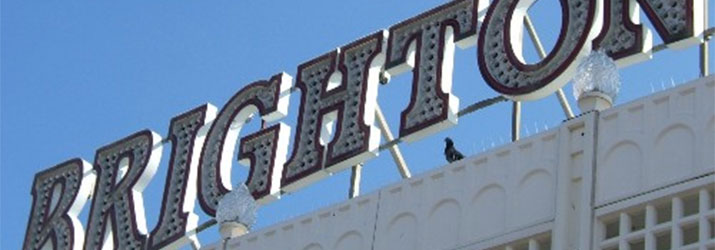
The ABN were welcomed to Brighton for four days of glorious sunshine and a stimulating mix of teaching, scientific break- throughs and case study conundrums. This year the ABN conference was brought right up to date with a conference app for smart phones and a dedicated twitter feed.
The conference opened on Monday the 28th with the medical student road show in parallel with the Specialist Registrar teaching session. The Registrar session, attended by over 70 trainees, kicked off with small group teaching on prescribing in epilepsy.There were then seminars on ‘Neurology on the ITU’ from Lionel Ginsberg, ‘How to interpret the EMG’ from David Allen and ‘Dementia’ from Jonathan Schott. The day was rounded off with Jeremy Isaacs describing how to get (and keep!) a first consultant job and Trevor Pickersgill showing how to negotiate a job plan once you have got it.
The main conference opened the following day and started with a teaching session on epilepsy, with Mark Manford reminding us of the importance of taking a good history, Tejal Mitchell exploring the use (and misuse) of the EEG and John Duncan describing advances in imaging technology allowing refined diagnosis and more targeted epilepsy surgery. Parallel sessions on improving neurology services and neuromuscular platform presentations came next. Michael Pearson gave the perspective of a Respiratory Physician on improving outcomes for patients by using national audit data to drive service change.
The 18th Gordon Holmes Lecture was delivered by John Leigh from Cleveland, Ohio describing the neuronal control of eye movements and their use as research tools.The afternoon teaching session covered head injury, an area often neglected by neurologists. We learnt about the acute management of head injury and the on going efforts to improve this,using clinical trials, from Maxwell Damian, the surgical options from neurosurgeon Peter Hutchinson and the long term consequences of head injury from Richard Greenwood. This was followed by parallel platform sessions on neurodegeneration and multiple sclerosis. The Neurolympic Challenge drew the day to a close. Quiz Master Phillip Smith pitted the regions against each other with the team comprising Scotland and Northern Ireland reigning supreme.The trainees’ dinner was held at Al Duomo restaurant.
Wednesday started early with a stimulating breakfast with neuro-ophthalmology experts followed by a teaching session on degeneration and regeneration of the nervous system. Parallel platform sessions followed on epilepsy and cerebrovascular disease. A highlight was the discovery by Lilleker and Mohanraj of anti-VGKC complex antibodies in a small proportion of patients with unexplained refractory epilepsy,
who became seizure free following immunomodulatory treatment. Walking tours of the posters followed lunch. Then the ABN Medallist, Mark Wiles, told us about learning neurology and that pyramidal pattern weakness does not exist. The day was rounded off with a movement disorders video session with many excellent videos including a case from Chris Allen of paroxysmal exercise-induced dystonia secondary to demyelination. The ABN Gala dinner at the Corn Exchange, Brighton Dome was well attended and was a great opportunity to unwind and digest the conference’s offerings so far.
The final day of the conference started with the ACNR sponsored case presentation competition where we were reminded that common diseases may present in atypical ways and sometimes, rare diseases can present like they are supposed to. Hugh Adler won the case presentation prize for his description of a patient with Ophelia syndrome associated with anti-mGluR5 antibodies. The plenary lecture from Iain McGilchrist looked at how the two hemispheres work in very different ways resulting in a kind of power struggle in our interaction with the world.
Brighton has a high incidence and prevalence of HIV and so it was fitting that the morning teaching session looked at this now manageable infection. Hadi Manji explained the effect of HIV on the brain, and, in particular, premature cogni- tive decline. Nick Davies categorised the immune reconstitution syndrome and Martin Fisher described his 30 years experience of dealing with the epidemic in Brighton. We were reminded of the importance of offering HIV testing to all patients with neurological symp- toms, as this is now an infection that can be controlled. The final teaching session of the conference was an overview of antibody-mediated neurology, an area where our knowledge is rapidly expanding and our understanding of the clinical phenotypes of each antibody and how to treat them deepening.
The clinicopathological conference was a complex case with many a red herring, but expertly discussed by Peter Enevoldsen. The audience was able to participate via twitter or text, but none clinched the final diagnosis of primary angiitis of the central nervous system.
An excellent conference attended by over 550 neurologists, trainees and medical students from across the UK and beyond. The level of poster and platform presentations was high and there were excellent opportunities to meet and socialise with old colleagues, in the glorious south coast sunshine. The Charles Symonds prizes for best platform presentation was won by Michaela Simoni and for best poster by Tim Shakespeare. As mentioned before, Hugh Adler won the case presentation prize. I am certainly looking forward to Glasgow 2013!